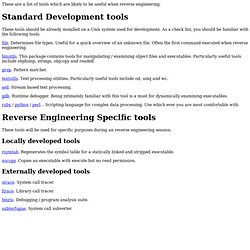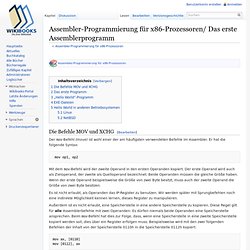

Tools. These are a list of tools which are likely to be useful when reverse engineering.

These tools should be already installed on a Unix system used for development. As a check list, you should be familiar with the following tools. file. Determines file types. Useful for a quick overview of an unknown file. Binutils. Grep. Textutils. Sed. Gdb. Ruby / python / perl... These tools will be used for specific purposes during an reverse engineering session. Locally developed tools rsymtab. Xocopy. Externally developed tools. Intro to Reverse Engineering - No Assembly Required.
Last time we went over the C programming language in an introductory article specifically focusing on getting the security professional on the road to coding (or at least the road to understanding).

This time around we extend the series of coding articles for non-programmers with an area of high interest in the infosec community, reverse engineering. This paper is intended as an introduction to reverse engineering for someone who has no experience whatsoever on the subject. You should have some basic knowledge of C programming, and access to a Windows or Linux box (preferably both) using the x86 architecture (i.e., your average computer). No knowledge of assembly code, registers, or the like is assumed, although it helps. The "Introduction" section of the paper is intended for the newcomer who has little or no understanding of what reverse engineering is and may be skipped by those looking for more technical details. Table of Contents 1) Introduction 2) Assembly Basics Introduction | | v. Assembler-Programmierung für x86-Prozessoren/ Das erste Assemblerprogramm. Die Befehle MOV und XCHG[Bearbeiten] Der mov-Befehl (move) ist wohl einer der am häufigsten verwendeten Befehle im Assembler.

Er hat die folgende Syntax: mov op1, op2 Mit dem mov-Befehl wird der zweite Operand in den ersten Operanden kopiert. Der erste Operand wird auch als Zieloperand, der zweite als Quelloperand bezeichnet. Es ist nicht erlaubt, als Operanden das IP-Register zu benutzen. Außerdem ist es nicht erlaubt, eine Speicherstelle in eine andere Speicherstelle zu kopieren. Mov ax, [0110] mov [0112], ax Der xchg-Befehl (exchange) hat die gleiche Syntax wie der mov-Befehl: xchg op1, op2 Wie sein Name bereits andeutet, vertauscht er den ersten und den zweiten Operanden. Das erste Programm[Bearbeiten] Schritt 1: Installieren des Assemblers Laden Sie zunächst den Netwide-Assembler unter der folgenden Adresse herunter: Dort sehen Sie eine Liste mit DOS 16-Bit-Binaries.
Schritt 2: Assemblieren des ersten Programms Anschließend kopieren Sie das folgende Programm in den Editor: Schritt 3: Analyse. Where to start in Reverse Engineering? « malwarereversing. Well given the recent take down of reverse-engineering.net for unknown reasons I’ve decided to mirror some content here.

I’ve formatted out some of the bits like user posts identities and cleaned up some formatting. Other than that I have NOT link checked so not sure what are good/bad links here. Hope you find it useful and woodmann.com will probably mirror the entire archive before to long. What do I learn first? —>>path 1: 1 ) visit to view some reversing videos that train you in the RCE basis. 2 ) check to find some visual solution submitted for crackmes. 3 ) Try to repeat the shown steps, and reproduce them with other crackmes. —>> path 2: